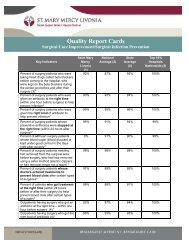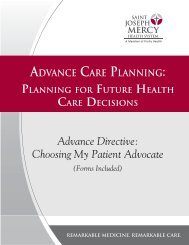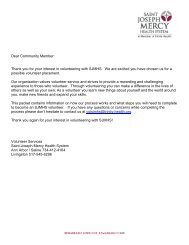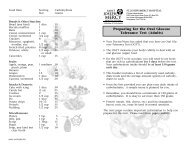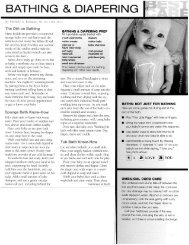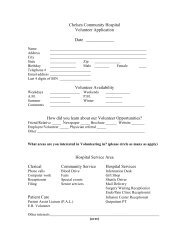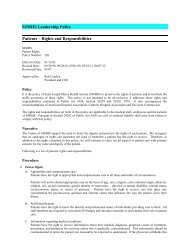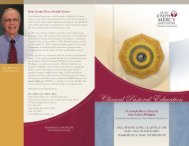Phillip J Bendick, PhD FSDMS William Beaumont Hospital Royal ...
Phillip J Bendick, PhD FSDMS William Beaumont Hospital Royal ...
Phillip J Bendick, PhD FSDMS William Beaumont Hospital Royal ...
Create successful ePaper yourself
Turn your PDF publications into a flip-book with our unique Google optimized e-Paper software.
<strong>Phillip</strong> J <strong>Bendick</strong>, <strong>PhD</strong> <strong>FSDMS</strong><br />
<strong>William</strong> <strong>Beaumont</strong> <strong>Hospital</strong><br />
<strong>Royal</strong> Oak, Michigan
Disclosures<br />
No relevant disclosures<br />
Speaker for -<br />
Gulfcoast Ultrasound<br />
GE Ultrasound
What’s New<br />
Accreditation<br />
Screening<br />
Markers for CV Disease<br />
Plaque Characterization<br />
CCSVI<br />
Physiologic testing for CVI<br />
3-D Vascular Ultrasound<br />
. . .
What’s New<br />
Accreditation<br />
All Technical Staff<br />
members must be<br />
credentialed by Jan, 2017
What’s New<br />
Accreditation<br />
IAC granted deeming<br />
status by CMS,<br />
which has led to . . .
What’s New<br />
Accreditation<br />
Audits and random<br />
site visits (once per<br />
cycle)
What’s New<br />
Accreditation<br />
Provisional accreditation<br />
Required conference call
What’s New<br />
Accreditation<br />
60 day comment period<br />
for any Standards change
What’s New<br />
Screening<br />
How to screen ??<br />
Whom to screen ??
What’s New<br />
§ Deal with the easy question first:<br />
How to screen
What’s New<br />
• How to screen<br />
ICAVL Standards –<br />
Appropriate equipment<br />
Qualified personnel<br />
Adequate protocols<br />
Appropriate criteria
What’s New<br />
Screening is NOT a diagnostic study !<br />
A typical diagnostic examination may<br />
have 30-40 images or more<br />
A typical screening study<br />
will have 4-8 images
What’s New
What’s New<br />
Screening is minimal sampling !<br />
As with any sampled system,<br />
it is subject to diagnostic<br />
“aliasing”<br />
The fewer the samples,<br />
the greater the aliasing !
What’s New<br />
Screening is minimal sampling !<br />
Requires:<br />
Skilled sonographer<br />
Knowledgable interpretation
What’s New<br />
Screening should be highly<br />
sensitive !<br />
Participants will not go directly to<br />
intervention based on screening.
What’s New<br />
Screening should be highly<br />
sensitive !<br />
Diagnostic thresholds for significant<br />
positive findings should be low –<br />
e.g.<br />
ICA PSV > 125 cm/sec
What’s New<br />
Which leaves the more<br />
difficult question:<br />
Whom to screen ??
What’s New<br />
Whom to screen<br />
Everyone § Impractical<br />
§ Cost prohibitive<br />
§ Ineffective
What’s New<br />
Whom to screen<br />
Everyone<br />
Nobody
What’s New<br />
Whom to screen<br />
Everyone<br />
Nobody<br />
Even if this were the correct<br />
answer,
What’s New<br />
Whom to screen<br />
Everyone<br />
Nobody<br />
Even if this were the correct<br />
answer, it can be done
What’s New<br />
Whom to screen<br />
Everyone<br />
Nobody<br />
Even if this were the correct<br />
answer, it can be done<br />
è it will be done
What’s New<br />
§ Whom to screen:<br />
What is the goal of screening?
What’s New<br />
§ Whom to screen:<br />
What is the goal of screening?<br />
Identify candidates for intervention
What’s New<br />
• Identify candidates for intervention<br />
Prevalence of significant carotid<br />
stenosis for cost-effectiveness*<br />
Derdeyn 1996 > 20%<br />
Lee 1997 > 40%<br />
Yin 1998 > 4.5%<br />
* In an otherwise perfect world
What’s New<br />
Pre-operative screening:<br />
1990s literature showed prevalence<br />
in CABG/PVD patients of 5-10%<br />
Prevalence approaches 20% if<br />
carotid bruit present
What’s New<br />
General population (Colgon, 1988) ~ 1%<br />
è US Preventive Services Task Force:<br />
There is inadequate evidence to<br />
support carotid screening at this time
What’s New<br />
§ Whom to screen:<br />
What is the goal of screening?<br />
Identify candidates at risk for CHD
What’s New<br />
If Framingham RS Low, 59% have<br />
carotid plaque<br />
If FRS Intermediate / High, 87% have<br />
carotid plaque<br />
Naqvi JASE 2010
What’s New<br />
If Framingham RS Low, 59% have<br />
carotid plaque<br />
If FRS Intermediate / High, 87% have<br />
carotid plaque<br />
So simply reverse engineer the problem!
What’s New<br />
Unfortunately, if carotid plaque used as a<br />
marker for CHD –<br />
The detection rate is only 62%<br />
The false positive rate is 30%<br />
Wald J Med Screen 2009
What’s New<br />
Carotid plaque does not have a screening<br />
performance that is sufficiently discriminatory<br />
between affected and unaffected individuals<br />
to be a worthwhile screening test.<br />
Wald J Med Screen 2009
What’s New<br />
§ Whom to screen:<br />
What is the goal of screening?<br />
Identify candidates for aggressive<br />
preventive medicine measures
What’s New<br />
200 million in US between 20 – 80 years<br />
75% eligible for risk reduction<br />
20% eligible for statins<br />
Cost: $60-80B / year
What’s New<br />
Anecdotes from a vascular screening program<br />
15-20% with carotid plaque<br />
~ 40% with carotid plaque in selected<br />
screenings
What’s New<br />
Identify candidates for preventive<br />
measures -<br />
There is no evidence that outcomes<br />
ultimately are improved!
What’s New<br />
In the evidence-based world of<br />
medicine, carotid screening<br />
does not occur
What’s New<br />
In our world (the real world), carotid<br />
screening occurs, but evidence is<br />
lacking at this time to define the<br />
appropriate population to be<br />
screened which will make it a<br />
cost-effective means of preventive<br />
medicine.
What’s New<br />
34 th Bethesda Conference (2002):<br />
Recommended an individualized approach<br />
to noninvasive atherosclerosis testing<br />
“based on physician recommendation and<br />
referral,
What’s New<br />
34 th Bethesda Conference (2002):<br />
“… only after a careful consideration of<br />
known medical history and evaluation of<br />
major standard cardiovascular risk factors<br />
by office-based techniques”<br />
Redberg JACC 2003
What’s New<br />
§ Whom to screen:<br />
What is the goal of screening?<br />
Refine “risk status” using<br />
markers for CV disease
What’s New<br />
Markers of CV Disease:<br />
ABI<br />
Flow mediated dilation (FMD)<br />
Intima – Media Thickness (IMT)
What’s New<br />
Markers of CV Disease:<br />
Ankle – Brachial Index<br />
Survival<br />
Years
What’s New<br />
Markers of CV Disease:<br />
Ankle – Brachial Index<br />
Significant existing disease
What’s New<br />
Markers of CV Disease:<br />
Flow mediated dilation
What’s New<br />
Markers of CV Disease:<br />
Flow mediated dilation<br />
Berry Clinical Science 2000
What’s New<br />
Markers of CV Disease:<br />
Flow mediated dilation<br />
Significant existing<br />
endothelial dysfunction
What’s New<br />
Markers of CV Disease:<br />
Intima – Media Thickness
What’s New<br />
Clinical Outcomes: MI / Stroke<br />
O’Leary NEJM 1999
What’s New<br />
Clinical Outcomes: Event Rate<br />
What’s New<br />
Automated Measurements<br />
Trace
What’s New<br />
Standardized Measurements<br />
Ø CCA vs Bifurcation vs ICA<br />
ICA<br />
CCA
What’s New<br />
Standardized Measurements<br />
Ø CCA vs Bifurcation vs ICA<br />
Ø Max IMT vs Mean IMT<br />
Ø Near wall vs Far wall<br />
Ø Absolute IMT vs Progression rate
What’s New<br />
Protocol:<br />
Patient supine<br />
Straight lateral, +/- 45 o approaches
What’s New<br />
Protocol:<br />
Patient supine<br />
Straight lateral, +/- 45 o approaches<br />
Distal CCA, far wall, 1cm segment<br />
R-wave gated hi-res digital images<br />
Triplicate measures, each view<br />
Measure mean IMT, Right & Left<br />
Stein et al, JASE 21(2):93-111 (Feb, 2008)
What’s New<br />
Protocol:<br />
Note – Extensive protocols with<br />
measurements from multiple<br />
sites are required for the precision<br />
necessary to observe a treatment<br />
effect
What’s New<br />
Simplified Protocol:<br />
Patient supine, facing up<br />
Straight lateral approach<br />
Distal CCA, 1-2cm segment<br />
Measure far wall, mean IMT<br />
Greater of Right vs Left
What’s New<br />
Standardized Measurements<br />
Typical values:<br />
Young healthy adults < 0.6 mm<br />
Adults, 45-55: Mod risk 0.7 – 1.0 mm<br />
High risk 1.0 – 1.5 mm<br />
Adults, > 55: Mod risk 0.8 – 1.1 mm<br />
High risk 1.1 – 1.5 mm<br />
Plaque > 1.5 mm<br />
Data Tables available in Stein et al, JASE 21:93-111 (Feb, 2008)
What’s New<br />
Markers of CV Disease:<br />
Intima – Media Thickness<br />
An indicator of future<br />
dysfunction / disease
What’s New<br />
Framingham Risk Score<br />
Female, 62 yrs 9<br />
Tot Cholesterol 228 3<br />
HDL Cholesterol 40 1<br />
SBP (treated) 134 3<br />
(+) Smoker 3<br />
Non-diabetic 0<br />
25% 10 yr. Risk
Using IMT Measurements<br />
Refining the FRS<br />
Vascular Age:<br />
“A man is as old as his arteries.”<br />
Thomas Sydenham, English physician, 1624-1689
Using IMT Measurements<br />
Refining the FRS<br />
Vascular Age:<br />
Measure IMT, assign age<br />
that has that value as the median,<br />
use that vascular age to<br />
calculate FRS
Vascular<br />
Age: IMT<br />
Trigger for<br />
aggressive<br />
risk factor<br />
Using IMT Measurements<br />
Refining the FRS<br />
management
What’s New<br />
Using IMT Measurements<br />
Framingham Risk Score<br />
Female, 62 yrs 9<br />
Tot Cholesterol 180 0<br />
HDL Cholesterol 45 1<br />
SBP (treated) 122 0<br />
(-) Smoker 0<br />
Non-diabetic 0<br />
9% 10 yr. Risk
What’s New<br />
Using IMT Measurements<br />
Framingham Risk Score<br />
Female, 62 yrs<br />
IMT<br />
1.0mm<br />
Vasc Age 80<br />
10 yr. Risk 15%
What’s New<br />
Using IMT Measurements<br />
Framingham Risk Score<br />
Female, 62 yrs<br />
IMT<br />
1.0mm<br />
Vasc Age 80<br />
10 yr. Risk 15%<br />
Potential for more aggressive Rx:<br />
BP, Lipids, Fitness level
What’s New<br />
Using IMT Measurements<br />
Framingham Risk Score<br />
Female, 62 yrs<br />
IMT<br />
0.6mm<br />
Vasc Age 45<br />
10 yr. Risk 4%
What’s New<br />
Using IMT Measurements<br />
Framingham Risk Score<br />
Female, 62 yrs<br />
IMT<br />
0.6mm<br />
Vasc Age 45<br />
10 yr. Risk 4%<br />
Current Rx may be adequate
What’s New<br />
Markers of CV Disease:<br />
Existing plaque<br />
Today’s problem
What’s New<br />
Cardiovascular Disease –<br />
Historically, the clinical significance<br />
of CV disease has been based on the<br />
severity of blockage (stenosis)
What’s New<br />
Stenosis assessment:<br />
Contrast angiography<br />
CTA<br />
MRA<br />
The new “non-invasive”
What’s New<br />
All of these techniques are<br />
image-based and provide<br />
anatomic information only –<br />
but is that the important data ??
What’s New<br />
Atherosclerotic Disease – Carotid<br />
Stroke Risk:<br />
Asymptomatic, > 70%<br />
5% / yr<br />
Symptomatic, > 70%<br />
15% / yr
What’s New<br />
Atherosclerotic Disease – Carotid<br />
Which implies NO stroke risk:<br />
Asymptomatic, > 70%<br />
95% / yr<br />
Symptomatic, > 70%<br />
85% / yr
What’s New<br />
Atherosclerotic Disease –<br />
Besides stenosis, what are the lesion<br />
characteristics that will identify<br />
the atherosclerotic plaque likely<br />
to become symptomatic?
What’s New<br />
Plaque Characterization:<br />
Not a new concept -<br />
Dixon S 1982<br />
Lusby RJ 1982<br />
Reilly LM 1983<br />
Johnson JM 1985<br />
<strong>Bendick</strong> PJ 1986<br />
Bluth EI 1986<br />
. . .
What’s New<br />
Atherosclerotic Disease –<br />
Early efforts at plaque characterization<br />
Identification of ulceration<br />
Plaque echogenicity
What’s New<br />
Atherosclerotic Disease – Ulceration<br />
Ultrasound criteria<br />
Heterogeneous lesion<br />
Sharp, irregular borders<br />
> 2mm crater
What’s New<br />
Atherosclerotic Disease – Ulceration
What’s New<br />
Atherosclerotic Disease – Ulceration<br />
Sx Patient, > 70% stenosis<br />
Non-ulcerated ~ 15% / yr<br />
Ulcerated<br />
~ 40% / yr
What’s New<br />
Atherosclerotic Disease – Echogenicity<br />
It’s what’s inside<br />
that counts
What’s New<br />
Atherosclerotic Disease – Echogenicity<br />
Plaque type using Ultrasound<br />
I<br />
II<br />
III<br />
IV<br />
Predominantly anechoic<br />
Heterogeneous, partly anechoic<br />
Heterogeneous, mostly echogenic<br />
Homogeneous, echogenic
What’s New<br />
Atherosclerotic Disease – Echogenicity<br />
Type I<br />
Type IV<br />
Need for objective plaque evaluation
What’s New<br />
Gray Scale Median (GSM)<br />
Ø Normalize image echogenicity
What’s New<br />
Gray Scale Median (GSM)<br />
Ø Use histogram feature
What’s New<br />
Gray Scale Median (GSM)<br />
Ø Clinical correlation<br />
Asymptomatic plaque:<br />
GSM 38 +/- 26<br />
Symptomatic plaque:<br />
GSM 21 +/- 15 p = .002<br />
Elatrozy Int Angiol 1998
What’s New<br />
Gray Scale Median (GSM)<br />
Ø Clinical correlation<br />
Echorich plaque: 50-79% 80-99%<br />
Relative stroke risk – 1.0X 3.1X<br />
Echolucent plaque: 50-79% 80-99%<br />
Relative stroke risk – 4.2X 7.9X<br />
Gronholdt Circulation 2001
What’s New<br />
Gray Scale Median (GSM)<br />
Ø Clinical correlation – ICAROS Study<br />
Complications of carotid stenting –<br />
GSM25<br />
Asx pts. 6.1% 0.6%<br />
Sx pts. 9.8% 3.3%<br />
Biasi Circulation 2004
What’s New<br />
Plaque Characterization:<br />
Where are we headed ?
What’s New<br />
The unstable plaque<br />
Metabolic activity<br />
è Inflammation<br />
è Collagen reduction<br />
è Thinning of fibrous cap<br />
è Plaque rupture<br />
è Heart attack / Stroke
What’s New<br />
New technologies -<br />
MSCT tissue characterization<br />
MRI / MRS<br />
PET / PET-CT<br />
IVUS / CE ultrasound<br />
OCT
What’s New<br />
Next generation ultrasound -<br />
Intravascular Ultrasound<br />
- Virtual histology<br />
Okubo et al<br />
Circ J 2008
What’s New<br />
Next generation ultrasound -<br />
Intravascular Ultrasound<br />
Okubo et al<br />
Circ J 2008
What’s New<br />
Next generation ultrasound -<br />
Contrast Enhanced Ultrasound **<br />
Plaque neovascularity<br />
Giannonni<br />
Eur J Vasc Endovasc Surg 2009<br />
** Off label use of ultrasound contrast;<br />
not FDA approved for this application
What’s New<br />
Next generation ultrasound -<br />
Contrast Enhanced Ultrasound **<br />
Plaque neovascularity<br />
Feinstein<br />
Radiology 2010<br />
** Off label use of ultrasound contrast;<br />
not FDA approved for this application
What’s New<br />
Next generation ultrasound -<br />
Contrast Enhanced Ultrasound **<br />
Plaque<br />
neovascularity<br />
Feinstein<br />
Radiology 2010
What’s New<br />
l<br />
CCSVI – Chronic CerebroSpinal<br />
Venous Insufficiency<br />
Identify hemodynamic<br />
/ anatomic abnormalities<br />
in the cerebro-spinal<br />
venous drainage system<br />
of patients with MS
What’s New<br />
l<br />
CCSVI<br />
Protocol – IJV (Rt + Lt)<br />
Supine and Upright<br />
Image sagittal and transverse<br />
Measure lumen diameter, crosssectional<br />
area (End expiration)<br />
Proximal, Mid and Distal
What’s New<br />
l<br />
CCSVI - IJV<br />
Supine: Dilated, good venous<br />
emptying, respiratory<br />
phasicity<br />
Upright: Collapsed, diminished<br />
venous emptying and<br />
respiratory phasicity
What’s New<br />
l CCSVI<br />
IJV - Supine<br />
CDI Sagittal
What’s New<br />
l<br />
CCSVI<br />
IJV - Supine<br />
B-mode<br />
Sagittal
What’s New<br />
l<br />
CCSVI<br />
IJV - Upright<br />
CDI Sagittal
What’s New<br />
l<br />
CCSVI<br />
IJV - Upright<br />
B-mode<br />
Sagittal
What’s New<br />
l<br />
CCSVI – IJV Supine
What’s New<br />
l<br />
CCSVI – IJV Upright
What’s New<br />
l<br />
CCSVI – Vertebral Veins<br />
Supine: Normal lumen,<br />
good venous emptying,<br />
respiratory phasicity<br />
Upright: Normal lumen, good /<br />
enhanced venous emptying,<br />
some loss of respiratory<br />
phasicity
What’s New<br />
l<br />
CCSVI – Intracranial Veins<br />
Transtemporal Window:<br />
Deep Middle Cerebral Vein<br />
Basal Vein (Rosenthal)<br />
Occipital Window:<br />
Internal Cerebral Vein<br />
Great Cerebral Vein(Galen)
What’s New<br />
l<br />
CCSVI – Intracranial Veins<br />
Evaluate for reflux flows<br />
with respiration
What’s New<br />
l<br />
CCSVI – Abnormal Findings
What’s New<br />
l<br />
CCSVI – Abnormal Findings
What’s New<br />
l<br />
CCSVI – Abnormal Findings<br />
Scale 5<br />
Scale 30
What’s New<br />
l<br />
CCSVI – Abnormal Findings<br />
Results are very preliminary<br />
Unverified by other centers<br />
Venous drainage abnormalities seen in<br />
up to 60-70% of patients with MS<br />
No long term followup after intervention
What’s New<br />
Evaluation<br />
for DVT
What’s New<br />
Use augmentation maneuvers for<br />
venous testing<br />
1975: “Blind” CW Doppler;<br />
no imaging capability<br />
2013: High resolution<br />
imaging groin to<br />
ankle
What’s New<br />
High resolution imaging groin to ankle
What’s New<br />
Augmentation maneuvers:<br />
Venous testing for DVT<br />
Provide no additional<br />
diagnostic information –<br />
“Augmentation … rarely<br />
provides additional<br />
information.”<br />
Lockhart et al AJR 2005
What’s New<br />
Augmentation maneuvers:<br />
Venous testing for DVT<br />
Provide no additional<br />
diagnostic information<br />
Are not required<br />
by ICAVL<br />
Waste time
What’s New<br />
Venous testing for DVT: ICAVL<br />
Spectral Doppler waveforms from<br />
the CFV and Popliteal Vein
What’s New<br />
Physiologic<br />
evaluation<br />
of CVI
What’s New<br />
Physiologic evaluation of CVI<br />
The Calf<br />
Muscle<br />
Pump
What’s New<br />
The calf muscle pump
What’s New<br />
Physiologic evaluation of CVI<br />
Primary / secondary VV
What’s New<br />
Physiologic evaluation of CVI
What’s New<br />
Physiologic evaluation of CVI
What’s New<br />
Physiologic evaluation of CVI
What’s New<br />
Physiologic evaluation of CVI<br />
Limitations:<br />
Operator / Technique dependent<br />
Patient compliance dependent<br />
Lack of reproducibility<br />
Time consuming
What’s New<br />
Physiologic evaluation of CVI<br />
Automated<br />
Quantitative
What’s New<br />
Physiologic evaluation of CVI<br />
Venous Outflow<br />
Venous Filling
What’s New<br />
Physiologic evaluation of CVI<br />
Multiphasic Testing
What’s New<br />
3-D Vascular Ultrasound<br />
<br />
Ultrasound Imaging – 1950s<br />
Bistable ultrasound<br />
Persistance oscilloscope images<br />
Water bath coupling (Patient and transducer)<br />
è Stereoscopic viewing
What’s New<br />
Ultrasound Imaging – 1990s
What’s New<br />
2011: In the time it takes to acquire<br />
a single 2-D image, we can now<br />
collect a complete<br />
volume set of data
What’s New
What’s New
What’s New<br />
l<br />
3-D Vascular Ultrasound
What’s New
What’s New<br />
3-D Vascular Ultrasound<br />
+<br />
ICA<br />
+<br />
ECA<br />
+<br />
+<br />
CCA<br />
ICA
What’s New<br />
ICA<br />
Automate<br />
using<br />
Macros<br />
ECA<br />
CCA
What’s New<br />
Tomographic Ultrasound Imaging (TUI)
What’s New<br />
Tomographic Ultrasound Imaging (TUI)
What’s New<br />
3-D Plaque characterization<br />
+<br />
ICA<br />
+<br />
ICA
What’s New<br />
3-D Plaque characterization
What’s New<br />
3-D Plaque characterization
What’s New<br />
3-D Plaque characterization
What’s New<br />
3-D Plaque characterization
What’s New<br />
The future<br />
of Ultrasound -<br />
is Now
What’s New<br />
You are only limited by your imagination !
What’s New



